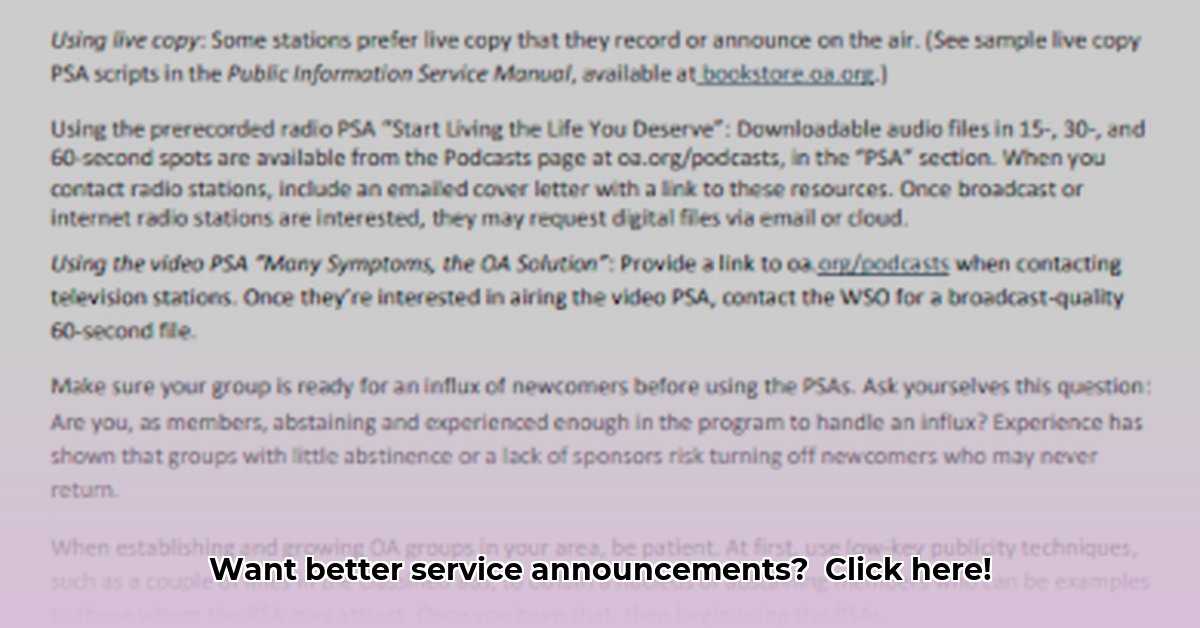Understanding the Power of PSAs
Public service announcements (PSAs) are powerful tools for social change, raising awareness and inspiring action on critical issues. They act as a megaphone for important causes, from health and safety to environmental protection and social justice. This article explores what makes a PSA effective, analyzes successful (and unsuccessful) examples, and provides a practical guide for creating your own impactful PSA.
Analyzing Effective PSAs: What Works and Why
A truly effective PSA blends creativity, strategy, and an understanding of human psychology. It’s more than just a catchy jingle or celebrity endorsement; it’s about connecting with your audience on an emotional level and motivating them to act.
Examples of Successful PSAs
Here are some PSAs that hit the mark, demonstrating key elements of effective communication:
-
Ad Council’s “Love Has No Labels”: This campaign used a live X-ray screen in a public square, initially showing skeletons embracing. As real couples (diverse in race, sexual orientation, and ability) emerged from behind the screen, the message of inclusive love became clear. This element of surprise created a powerful emotional connection and challenged societal norms. The campaign’s viral success suggests its message resonated deeply.
-
Truth Campaign’s “Finish It”: Taking a different approach, “Finish It” exposed the manipulative tactics of the tobacco industry. Its raw honesty and focus on empowering youth resonated with the target audience and may have contributed to declining youth smoking rates.
-
Always’ “Like a Girl”: This campaign cleverly flipped the negative connotations of the phrase “like a girl” by showcasing the athleticism and strength of young girls. It effectively challenged stereotypes and empowered a generation.
-
Sandy Hook Promise’s “Back-to-School Essentials”: Starting like a typical back-to-school ad, this PSA takes a chilling turn, highlighting the potential for school violence. This stark reminder left a lasting impression and sparked important conversations.
Examples of Less Effective PSAs
Analyzing less successful campaigns helps us learn from past mistakes:
-
“This is Your Brain on Drugs”: While widely broadcast, this PSA’s simplistic, fear-based approach may have oversimplified a complex issue, leading to parodies and potentially minimizing its impact. Research suggests that fear tactics may not be effective long-term.
-
South Dakota’s “Meth. We’re On It.”: This campaign’s ambiguous slogan unintentionally became a source of ridicule, highlighting the importance of clear and concise messaging.
Creating Your Own Impactful PSA: A Step-by-Step Guide
Ready to create your own PSA? Here’s how:
-
Define the Issue: Specify the social problem you’re addressing. For example, instead of “pollution,” focus on “reducing plastic waste in local waterways.”
-
Identify Your Target Audience: Understand their values, concerns, and communication styles.
-
Craft Your Core Message: What’s the one key takeaway? Keep it concise and impactful.
-
Develop a Creative Concept: Brainstorm unique and memorable ways to convey your message.
-
Choose Your Medium: Video, radio, social media, print – select the platform that best reaches your target audience.
-
Write a Script/Storyboard (if applicable): Develop a compelling narrative.
-
Produce Your PSA: From smartphone videos to professional productions, choose a production level appropriate for your resources.
-
Plan Your Distribution Strategy: Where will your audience see or hear your PSA? Consider online platforms, social media, local media outlets, community events, and partnerships with relevant organizations.
-
Measure Your Impact: Track website visits, social media engagement, or changes in related behaviors to assess your PSA’s effectiveness.
Tips for Maximizing Your PSA’s Impact
- Keep it Brief: Capture attention quickly with concise messaging.
- Connect Emotionally: Engage your audience’s feelings through storytelling, humor, or empathy.
- Make it Memorable: Use strong visuals, a catchy tagline, or a compelling story.
- Provide a Clear Call to Action: Tell your audience exactly what they can do to make a difference.
- Test and Refine: Get feedback before launching and make necessary adjustments.
- Authenticity: Be genuine in your messaging. Avoid anything that feels forced or inauthentic.
- Consider Tone: Does the issue call for humor, seriousness, or a blend of both?
- Partnerships: Could collaborating with a well-known figure or organization amplify your message?
The Future of PSAs in a Digital Age
Social media has democratized PSA creation, allowing individuals and groups to share messages globally. This presents incredible opportunities for impactful storytelling and social change. Ongoing research into effective communication strategies and audience engagement will likely shape the future of PSAs, leading to even more impactful and compelling messages for social good.
- Hydro Extrusions USA Leads North American Aluminum Profile Solutions - December 28, 2025
- Hydro North America Leads Aluminum Extrusion Solutions Across Diverse Industries - December 27, 2025
- Hydro Extrusion North America Provides Custom Solutions Across Diverse - December 26, 2025
















